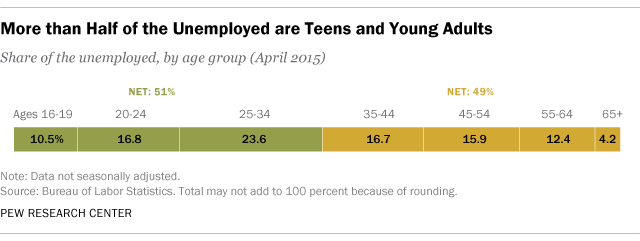
At 5.4%, April’s seasonally adjusted unemployment rate was the lowest it’s been in seven years, though essentially unchanged from March, according to Friday’s jobs report from the Bureau of Labor Statistics. That’s a 4.6-percentage-point drop since October 2009, when it peaked at 10%. No doubt, this trend should be good news for job seekers.
But if you’re a teenager or young adult, you’re much less likely to have seen significant job market improvement compared with older adults. Our analysis of the latest employment data finds that last month, more than half (50.9%) of the nation’s nearly 8 million unemployed people are between the ages of 16 and 34 – even though that group makes up just over a third of the civilian labor force.
In a sense, though, that disparity represents a return to normal patterns. The youngest age cohorts consistently have the highest unemployment rates – at least since 2000, which is as far back as we ran the numbers. And while unemployment soared among all age groups during the Great Recession, the youngest workers were hit exceptionally hard: In 2010, unemployment averaged 25.8% among 16- to 19-year-olds, and 15.5% among 20- to 24-year-olds. (While these age-specific data aren’t adjusted for seasonal variations, they only include people working or actively looking for work – not, for instance, people who aren’t counted as part of the labor force because they’re still in school.)
 The recession, in fact, acted to spread out unemployment a bit more evenly across age groups. At the peak of the previous business cycle, in December 2007, 53.2% of the unemployed were ages 16 to 34, and 35.4% were ages 35 to 54. In January 2010, when non-seasonally adjusted unemployment peaked, the youngest adults’ share had fallen to 47.4%, while the 35-to-54 share rose to 38.9%.
The recession, in fact, acted to spread out unemployment a bit more evenly across age groups. At the peak of the previous business cycle, in December 2007, 53.2% of the unemployed were ages 16 to 34, and 35.4% were ages 35 to 54. In January 2010, when non-seasonally adjusted unemployment peaked, the youngest adults’ share had fallen to 47.4%, while the 35-to-54 share rose to 38.9%.
Since then, unemployment has come down sharply across all age groups, but it’s fallen the least for – you guessed it – the youngest workers. The unemployment rate for 16- to 19-year-olds last month was 15.6%, a 42% decrease from the level in January 2010. Among 35- to 69-year-olds, who account for more than three-fifths of the civilian labor force, just 3.9% were unemployed in April, a 55% decline from the January 2010 level; there were only minor variations within that older group.



